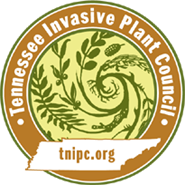Lonicera japonica Thunb.
Japanese Honeysuckle| Threat Level | Category |
|---|---|
| Established | Vine |
|
Similar Species May be confused with the following native and/or non-native species. Landscape Alternatives lists native horticultural substitutes |
Gelsemium sempervirens Lonicera spp. |
|---|

Description
Height
Japanese honeysuckle is a semi-evergreen to evergreen woody vine, high climbing and trailing to 80 feet (24 m) long, branching and often forming arbors in forest canopies and/or a groundcover under canopies.Stem
Slender woody vine becomes stout to 2 inches (5 cm) in diameter, round in cross section with opposite branching. Stems are brown and hairy becoming tan barked, fissured, and sloughing with age. It roots at low nodes and has long woody rhizomes that sprout frequently.Leaves
Leaves are opposite, broadly ovate to elliptic to oblong with rounded bases and blunt-pointed to round tips. Leaves measure 1.6 to 2.6 inches (4 to 6.5 cm) long and 0.8 to 1.5 inches (2 to 4 cm) wide. Leaf margins are entire but often lobed in early spring. Both surfaces are smooth to rough hairy, appearing whitish underneath.Flowers
From April to August, Japanese honeysuckle flowers in axillary pairs, each 0.8 to 1.2 inches (2 to 3 cm) long, on a bracted stalk. Blossoms are white (or pink) and pale yellow and fragrant. Thin tubular shape flares into five lobes in two lips (upper lip four-lobed and lower lip single-lobed), with the longest lobes roughly equal to the tube. Five stamens and one pistil all project outward and becoming curved. Sepals are persistent.Fruit and seeds
June to March. Nearly spherical, glossy berry starts green and ripens to black, 0.2 inch (5 to 6 mm) on stalks 0.4 to 1.2 inches (1 to 3 cm) long. Each berry contains two to three seeds.Images
Photo: Chuck Bargeron, University of Georgia, Bugwood.orgMore images of Lonicera japonica
Life History
Japanese honeysuckle is a semievergreen to evergreen woody vine, high climbing and trailing to 80 feet (24 m) long, branching and often forming arbors in forest canopies and/or a groundcover under canopies. Long woody rhizomes sprout frequently. The most commonly occurring invasive plant, Japanese honeysuckle overwhelms and replaces native flora in all forest types over a wide range of sites. It is a member of the Caprifoliaceae or Honeysuckle familyEcology and Habitat
Japanese honeysuckle occurs as dense infestations along forest margins and right-of-ways as well as under dense canopies and as arbors high in canopies. It is shade tolerant and persists via large woody rootstocks and spreads by rooting at vine nodes and animal-dispersed seeds.Origin and Distribution
Introduced from Japan in the early 1800s, Japanese honeysuckle is a traditional ornamental landscape plant. It is also valued as deer browse and is still planted in wildlife food plots, as well as use for erosion control.Other states where invasive: HI, FL, TX, OK, KS, MO, IL, WI, MI, IN, KY, OH, WV, VA, NC, SC, GA, MD, NJ, PA, NY, NH, MA, CT, RI, DE, VT. Federal or state listed as noxious weed, prohibited, invasive or banned: CT, MA, NH, VT.
Source: Information on this plant page is derived primarily from James H. Miller's Nonnative Invasive Plants of Southern Forests, USDA Forest Service.
Management Recommendations
Mechanical Controls
Prescribed burning in spring will reduce dense ground mats and sever climbing vines for more effective herbicide treatments to resprouting vines.Herbicidal Controls
Foliar Spray Method
Apply Escort with a surfactant to foliage June to August either by broadcast spraying 2 ounces per acre in water (0.6 dry ounces per 3-gallon mix) or by spot spraying 2 to 4 ounces per acre in water (0.6 to 1.2 dry ounces per 3-gallon mix).Or, treat foliage with one of the following herbicides in water with a surfactant (July to October or during warm days in early winter) keeping spray away from desirable plants: a glyphosate herbicide as a 2-percent solution (8 ounces per 3-gallon mix) or triclopyr as a 3- to 5-percent solution (12 to 20 ounces per 3-gallon mix).
Cut Stump Method
Cut large vines just above the soil surface and immediately treat the freshly cut stem with a glyphosate herbicide or triclopyr as a 20-percent solution (2.5 quarts per 3-gallon sprayer) in water with a surfactant July to October (safe to surrounding plants).Nontarget plants may be killed or injured by root uptake.
